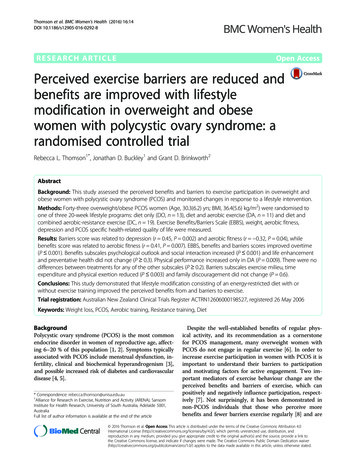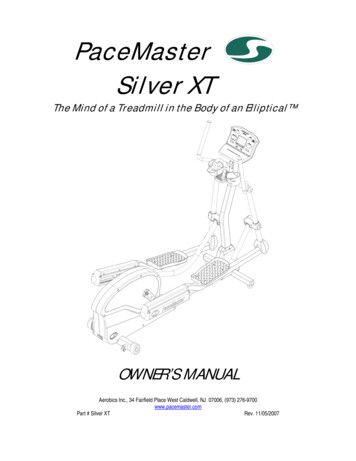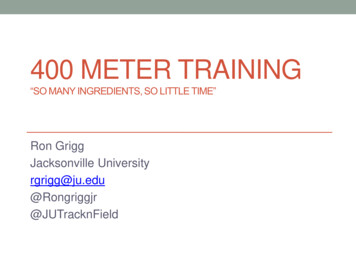
Transcription
Click in this document to reuturn to Septic System Information at InspectAPedia.comAEROBIC SYSTEMS, INC.2885 Highway 14 East Lake Charles, Louisiana 70607(337) 474-2804 phone (337) 477-7904 faxwww.hootsystems.comDRIP DISPOSAL DESIGN & INSTALLATION GUIDEThis manual is expressly to convey recommendations to guide in the design and installation of the Hoot Drip Irrigation and Management System. These recommendations areonly suggestions and local regulations, if more restrictive, must be followed, regardless ofour recommendations. Installers must follow the design of the Professional Engineer whohas designed the system for the specific design application.
WARNING! TO PREVENT MALFUNCTION OF YOUR SEWAGE SYSTEM, DO NOT DISCHARGETHE FOLLOWING MATERIALS INTO THE SYSTEM: Plastic Materials ! Cloth ! CigaretteStubs ! Large quantities of acids or caustics, soaps or cleaning materials which have a high or lowpH factor (Use low suds detergents) ! Throw-away Diapers !Baby wipes !Paper Towels !Kleenex & some toilet tissues which do not decompose readily in water ! Rubber products ! Excess grease or fatty materials (Use garbage disposal sparingly) ! Oily materials, motor oils, grease,kerosene, gasoline, Paints, etc. ! Backwash water from water softeners ! Any other materialswhich do not disintegrate readily in water ! Gutters ! Pool Filter Discharge ! Hot Tubs/JacuzziWater ! SUMP PUMP DISCHARGEWARNING! TO FUNCTION PROPERLY, THE HOOT SYSTEM MUST BE MAINTAINED BY AQUALIFIED PROFESSIONAL AT LEAST EVERY SIX (6) MONTHS FOR THE LIFE OF THE SYSTEM. FAILURE TO MAINTAIN THE HOOT SYSTEM VOIDS THE LIMITED WARRANTY ANDMAY CAUSE SERIOUS BODILY INJURY OR ILLNESS TO PEOPLE AND PETS AND MAYCAUSE SERIOUS DAMAGE TO THE HOOT SYSTEM OR OTHER PROPERTY.DANGER! ONLY A QUALIFIED PROFESSIONAL SHOULD ATTEMPT TO REPAIR OR FIX THEHOOT SYSTEM. ATTEMPTED REPAIR BY ANYONE OTHER THAN A QUALIFIED PROFESSIONAL MAY CAUSE SERIOUS BODILY INJURY OR DEATH TO THE HOMEOWNER OROTHER PERSONS AND MAY CAUSE SERIOUS DAMAGE TO THE HOOT SYSTEM ANDOTHER PROPERTY.DANGER! DO NOT DISCONNECT THE POWER TO THE HOOT SYSTEM. DISCONNECTION OFTHE POWER FROM THE SYSTEM MAY CAUSE SERIOUS ILLNESS OR DEATH TO THEHOMEOWNER AND OTHER PERSONS AND MAY CAUSE SERIOUS DAMAGE TO THE HOOTSYSTEM AND OTHER PROPERTY.WARNING! IN CASE OF IMMINENT FLOOD, IMMEDIATELY TURN OFF THE ELECTRICALPOWER TO THE HOOT SYSTEM AT THE INDEPENDENT BREAKER LOCATED ON THEHOUSE. FAILURE TO TURN OFF THE ELECTRICAL POWER MAY CAUSE SERIOUS INJURYOR DEATH TO THE HOMEOWNER AND OTHER PERSONS AND MAY CAUSE SERIOUS DAMAGE TO THE HOOT SYSTEM AND OTHER PROPERTY.WARNING! IF THE UNIT FAILS TO FUNCTION PROPERLY, DO NOT USE THE BATHROOM FACILITIES UNTIL QUALIFIED PERSONNEL FIX THE PROBLEM. USE OF THE BATHROOM FACILITIES DURING A SYSTEM FAILURE MAY CAUSE SERIOUS INJURY, ILLNESS, OR DEATHTO PERSONS AND MAY CAUSE SERIOUS DAMAGE TO THE HOOT SYSTEM AND OTHERPROPERTY.WARNING! DO NOT ALLOW CHILDREN TO PLAY ON OR AROUND THE AEROBICTREATMENT SYSTEM, DISPOSAL SYSTEM, OR OTHER OVER-LAND DISCHARGEAREA. ALLOWING CHILDREN TO PLAY IN THESE AREAS MAY CAUSE SERIOUSBODILY INJURY, ILLNESS, OR DEATH TO THE CHILDREN AND OTHER PERSONSAND MAY CAUSE DAMAGE TO THE HOOT SYSTEM AND OTHER PROPERTY.DANGER! DO NOT OPEN CONTROL PANEL WITHOUT ELECTRICITY DISCONTENTEDAND LOCKED OUT ON THE SYSTEM. FAILURE TO DO SO COULD CAUSE SEVEREINJURY OR DEATH- Page 1 -
Drip Design GuideI. Introduction to DripThe purpose of this design guide is to detail theequipment and design considerations necessary for the effective application of Hoot AerobicSystems utilizing drip irrigation technology tothe onsite wastewater field.Drip Irrigation was originally developed for theagriculture industry as a technique to improvethe efficiency of water delivered to plants, especially in environments where water supply islimited. The technique involves delivering onlythose amounts of water that plants actually useinto the root zone, and relying on horizontal aswell as vertical movement through the soil todisperse the water. Hoot Aerobic Systems utilizes components supplied by the Netafim Corporation, a world leader in drip applications.Their products, including pressure compensating emitters, filters, valves and other productshave become industry standards.It has come to our attention that systems areand reliable treatment and disposal of wastewater on-site has created a climate for change beyond septic tanks and drainfields.Hoot Aerobic Systems has responded with improved technology for wastewater treatmentand regulations have become more explicit andscientifically based. These are key reasonswhy interest in drip disposal within the on-siteindustry has rapidly increased.While the EPA and the Florida Department ofHealth have identified on-site disposal of wastewater as a satisfactory long-term solution, it isstill necessary to prevent human contact withcontaminants and pathogens in untreatedwastewater. Examples of failures of this requirement are:Surfacing of Failing Conventional SepticSystemsUnder treated effluent entering groundwaterContact of wastewater with surfacewaters in lakes or streamsThe goal of delivering water in the shallow subsurface and in the root zone of plants enablesthe wastewater designer to take advantage ofevapotranspiration, plant uptake for nutrient removal, and slow dispersal in the soil medium.With High levels of Pre-Treatment, provided bythe Hoot Aerobic System, and physical filtrationof the effluent, failed drainfields are a thing ofthe past. If the system fails, the problem is inthe tank, which can be pumped, not a drainfieldthat needs to be replaced.Within the last few years, the EPA has recognized that on-site treatment and disposal ofwastewater is a permanent alternative ratherthan a temporary solution for wastewater treatment and disposal when centralized collectionsystems are not feasible. Increasing publicconcern about issues related to the effectiveAs the demand increases for residential development in rural areas and in sub-optimal conditions for onsite wastewater disposal, the significance for alternative technologies increases.The use of a Hoot Aerobic System with drip disposal is the most effective strategy for a widevariety of the most demanding on-site wastewater design parameters.In addition to simply “getting rid of” wastewater,drip disposal has a number of benefits:- Page 2 -Water can be re-used for irrigation oflawns, shrubs, or trees;
The disposal area can remain intact, taking advantage ofnatural or modified land scape strategies;Beneficial wastewater nutrients areavailable for plant uptake;With proper design, drip irrigation can beapplied in almost any climate or soilconditions.The following design manual provides basic design guidelines for drip system design, installation, maintenance, and operation. However, because such designs aresubject to state and local regulatory requirements for on-site wastewater systems, any regulatory specification must begiven precedence over the recommendations included herein. If local regulationsallow design parameters which exceed thefollowing recommendations, the designershould bear in mind that the followingrecommendations are based on actualdesign experience and analysis of a variety of failed on-site systems.Common causes of drip system failure include:Overestimation of soil absorptionpotentialUnderestimation of wastewater loadPoor system layoutsInappropriate dosing schedules.Recommendation: use state regulationsonly when they are more restrictive thanthis design guide, not less restrictive.This can easily be achieved by any properly designed and maintained Hoot Aerobic System.Effluent leaves the Hoot Treatment systeman enters an adequately designed storagetank. The Storage tanks are designed toallow for both a working level and reservecapacity above the high water level alarm.The drip system is designed to distribute thewastewater uniformly over the drip field andthroughout the 24 hour day. The drip control system regulates this flow and can provide for backflushing, zone shifting, and alarms whenever operational conditions are exceeded.Since drip tubing requires operating pressure, thisdesign manual is built around our 20 GPM HootEffluent Blaster. Pressure is also required to operate filters (automatic or manual back flush), whichare necessary to remove organic and inorganicsuspended solids. These suspended solids can bea significant problem for drip emitters and can evenclog piping over time. Zone layout is necessary tokeep pumps small and inexpensive. Yet pump capacity must allow for the achievement of scouringvelocity (2 ft. per second) at the return ends of distribution lines and drip tubing during manual orautomatic field flush cycles.Drip tubing is normally installed at a minimumdepth of 6”, but 10” to 12” depths are recommended to minimize human contact potential. Coldclimates may require even deeper burial, based onlocal conditions. Installation below the soil freezedepth is generally safe, but there are examples ofsatisfactory installations at relatively shallowdepths in cold climates if there is a continuous flowof wastewater—even highly treated wastewater. Itappears that the warmth of the wastewaterachieved by circulation in a residence and by oxidation of the organics prevents freezing in the soil,even when soil moisture would normally freeze.Most critical to a proper design is matching the soilcapacity to absorb water with the demand for disposal of the design flow. In this regard, the designer must take account of water flow over, into,and through the soil; storage of water in the soilcolumn; the loss of water to the air through evaporation; loss through uptake in the roots; and exchange to the air through the leaves of plants(evapotranspiration).The following design guide shows in more detailhow accurate information about daily wastewaterflow, along with proper soil analysis and siteevaluation, can lead to a properly sized complete,successful, and cost-effective drip system.- Page 3 -
II. Wastewater Flow DeterminationA drip disposal system must accommodate the amount of wastewater effluent generated. Thefollowing table can be used for estimating the daily wastewater production rate for various activities. Actual water usage data or other methods of calculating wastewater usage rates mustbe used by the system designer if it is determined that, for whatever reason, these quantitiesexceed the standard estimates. In any case, estimates used for on-site wastewater treatmentdesigns must be approved by local regulatory authorities. The following table from EPA iswidely used for wastewater flow estimation.USAGE RATEGALLONS/DAY(Without Water Saving Devices)USAGE RATEGALLONS/DAY(With Water Saving Devices)Single family dwelling (one or two bedrooms) - less than 1,500 sq. feet.225180Singe family dwelling (three bedrooms) - less than 2,500 sq. feet.300240Single family dwelling (four bedrooms) - less than 3,500 sq. feet.375300Single family dwelling (five bedrooms) - less than 4,500 square feet.450360Single family dwelling (six bedrooms) - less than 5,500 square feet.525420Greater than 5,500 square feet, each additional 1,500 square feet orIncrement thereof.7560Condominium or Townhouse (one or two bedrooms)Condominium or Townhouse (each additional bedroom)2257518060Mobile home (one or two bedrooms)Mobile home (each additional bedroom)2257518060Country Clubs (per member)2520Apartment houses (per bedroom)125100Boarding schools (per room capacity)5040Day care centers (per child with kitchen)Day care centers (per child without kitchen)25152012Factories (per person per shift)1512Hospitals (per bed)200160Hotels and motels (per bed)7560Nursing homes (per bed)10080Laundries (self service per machine)250200Lounges (bar and tables per person)10854Office buildings (no food or showers per occupant)Office buildings (with food service per occupant)5104Parks (with bathhouse per person)Parks (without bathhouse per person)151012Restaurants (per seat)Restaurants (fast food per seat)351528Schools (with food service & gym per student)Schools (without food service)251520Service stations (per vehicle)108Stores (per washroom)200160Swimming pool bathhouses (per person)108RV / Travel Trailer (Per Space)5040Vet clinics (per animal)108Construction sites (per worker)5040Youth camps (per camper)3024TYPE OF FACILITYMovie Theaters (per seat)- Page 4 -
III. Site CharacteristicsE.Before doing any detailed design specification,it is necessary to evaluate specific site features.This assessment should include the following:A. Site Boundaries: Most state rules will haveregulations on how close drip lines maybe placed to property lines, home foundations, and other permanent propertyfeatures. Follow local rules for set backsfrom these boundaries.B. Special Features: Community waterdistribution lines, property and utilityeasements, wells, treatment systems,water lines from wells etc. require setbacks. Surface waters, including ponds,lakes, streams and even Intermittent water courses also require specific setbacks, typically 75 feet. Be certain toFollow local regulations for set backs.C. Future Land Use Restrictions The dripfield can be installed under a permanentlawn, among trees, or other landscapefeatures, provided set backs are followed. Any future permanent structuresthat will affect soil texture and water flowthrough the soil must be avoided over adrip field, including but not limited to thefollowing: out buildings, parking areas,swimming pools, tennis courts, home additions, decks, etc. The designer shouldconsult with the homeowner regardingany anticipated improvements to theproperty, and avoid these areas.D.Slopes: Drip disposal encourages lateral, not just vertical movementthroughout the soil. This does not restrict disposal fields to level areas, especially with the use of pressure compensating emitters and zoning. However, it will increase the amount ofland needed depending on the severity of the slope The following chart,from the State of Virginia, demonstrates that considerations of slopemust include information about the soildepth. Additional considerationsabout slopes include1) whether there is a natural orartificial barrier down slopefrom the proposed site thatmight provide opportunities forwater to surface (such as hillside cuts or walls),2) whether the drip tubing can belaid out on the contours of theslope, and3) whether the design can incorporate air release valves, checkvalves, zones, and other meansto equalize flow and to preventdrainbacks.Absorption Area Increase (percent)Slope of Site (percentage)Depth to Impervious10 to 19 20 to 29 30 to 39 40 to 50(Rock, pans, etc.)Drip Tubing, 24" offImpervious strata17%33%50%67%Drip Tubing 24" or moreoff impervious strata0%17%33%50%Precipitation: If the site is in an areawhich experiences seasonal, intense,and even short duration precipitationevents which cause collection of waterfrom surrounding areas or ponding ofwater on the soil surface, then specialattention should be directed towardregrading the soil surface to encourage direct precipitation run off.- Page 5 -G.Prior Land Use: Research should beconducted to determine if there wereany prior activities on the proposedsite that would affect soil characteristics. These effects include compaction, foreign soils, buried materials, etc.With consideration of the above issues, andany similar issues that the designer believesmay affect soil absorption rates, the designeris ready to evaluate the specific soil characteristics.
IV. Soil AbsorptionAfter the drip disposal area has been identified,the designer must undertake a thorough studyof the specific soil characteristics of the proposed field. Particular focus must be given toTexture, Loading Rates, Native vs. DisturbedSoils, and Restrictive layers.A. Sample CollectionAn accurate representation of the overall siteconditions requires a determination of theunderlying soil characteristics. A minimum of 2samples per proposed zone is necessary. Thesample shall be a three dimensional soil coresample which extends into the soil a minimum of2 feet deeper than the proposed location for thedrip tubing. The analysis of the soil core shouldnot only be for the texture, but should includeanalysis for presence of ground water, seasonalhigh water tables, restrictive layers, etc. USDA/NRCS Soils Maps or other locally available geological maps should be consulted to determineconsistency between observed and referencedconditions. Any inconsistencies should lead thedesigner to undertake further investigations of thesite particulars and history.B. Soils and Site Characteristics: Thefollowing USDA Chart should serve as an outlineto determine soil composition, therefore textureand suggested loading rates.- Page 6 -
C. Determining Soil TextureAccurate analysis of several samples collectedacross the proposed site area is critical todetermining the absorptive capacity of the soil.The designer must locate the soil on the USDASoil Chart to establish the soil classification. Ifthe samples from the different locations of theproposed site are different, the design must bebased on the most restrictive sample. Thesystem designer should always consult with aRegistered Soil Scientist, Site Evaluator or SoilsStructure Laboratory for assistance indetermining an accurate soil textureclassification.D. Restrictive LayersMany soil environments are surrounded byother soils with less desirable characteristics. Itshould be recognized that water movementthrough multiple soil types will be determined bythe characteristics of the most restrictive types.Therefore, whenever these restrictive types areencountered in a proposed drip field, theyshould provide the operative design criteria. Inparticular, soil absorptive capacities should bebased on those of restrictive layers rather thanthose of the more absorptive soils. If restrictivelayers are present within two feet below the dripline, then the designer should use the reducedloading rates of the restrictive layer to preventsystem failure. The greater the soil depth to arestrictive layer, the better.If the proposed drip field employs fill material,artificially compacted soils, or mixed soils,special considerations apply. Although the fillmaterial may have a greater soil absorptivecapacity, a design should not rely on the bettersoil classification if the underlying poor soil isstill present and utilized in the drip systemdesign. Mixing or tilling of the soils mayincrease the soil absorptive capacity. However,adding Class II soils to a Class IV site doesNOT yield a Class III absorptive capacity. Aproper analysis by a soils laboratory(engineering rather than agricultural focus) isnecessary to determine the new soilcharacteristics. Any time a drip field isconstructed with added soil, the overall fieldshould be larger than called for in the design,and the loading rate should be determined bythe restrictive layers rather than by theconstructed soils.The following “soup bowl” configuration demonstrates the problem. If the bowl area isscooped out and replaced with more absorptivesoils, system failures may still occur becausethe water will be trapped in the bowl. Conversely, if the situation is revered, in a “mound”configuration, water will tend to escape at theIn the two to four foot range below the drip tubing, if there is a change in the soil classificationof one unit or more, or if a boundary layer ispresent (rock, tight clays, etc.), then the disposal area must be increased to prevent failure.E. Native vs. Disturbed SoilsNative, non-disturbed soils are always the mostdesirable medium for drip application. However, if the soils are very poor, or the site conditions (e.g., available space) are so limited, thenthe designer can consider the introduction of fillmaterial.interface between the imported and native soils.With the above constraints used to define theoverall characteristics of the proposed drip disposal site, the designer is now prepared to es-- Page 7 -
V. Soil Hydraulic Loading RateThe maximum hydraulic loading per unit area ofsoil is determined by the soil textureclassification. Different soil textures havedifferent porosities and therefore enable differentquantities of water to pass through the soil. Indrip disposal, the goal is shallow disposal, notdeep percolation or surfacing. Therefore soiltextures at the surface and at depth areimportant to enable wastewater flow bothhorizontally and vertically. The key to successfuldrip system design is to load the soil at an evenrate near the surface, therefore promoting plantuptake and evapotranspiration. Therecommended loading rates for each soilclassification are as follows:Default: The designer should take intoaccount that the proposed loading ratesare for optimal soil conditions, and anyof the above mentioned constraints, including but not limited to: Special Features, Precipitation, Slopes, Prior andAdjacent Land Uses, ImperviousBoundaries, etc. must be considered inthe design. When in doubt, always default to lower application rates.Some states have regulations specifying loadingrates that are sometimes more restrictive andsometimes more generous than the above. Thedesigner must follow regulations, but otherwiseshould opt for more conservative designs.Soils Range From Class I Sandy soilsThe basic rule for drip disposal area is:Application Area Daily Flow / Loading RateVariations in the recommended rates enable thedesigner to take account of special circumstances, such as vegetation, precipitation, wind,or other factors that can remove water from theimmediate vicinity of the drip emitter. In allcases, using the higher application rate may result in a system failure. When it comes to design, the more conservative the approach, thebetter. Remember, the least expensive part ofthe overall drip system is the tubing.to Class IV Tight, Restrictive, Clays.Soil ClassificationRecommended LoadingRate (gal/sq. ft)Maximum LoadingRate (gal/sq. ft)I0.51.5II0.250.3III0.150.2IV0.050.1- Page 8 -
VI. A. System DesignThe following discussion describes the key mechanical elements of the overall drip system. Asimple schematic design for onsite wastewater disposal using drip is follows:LoopFlex ConnectVI. B. ComponentsPump: Although systems can be designed to use most any commercially available pressurepump, the Hoot Blaster 20EB is the supplied pump for these systems. Its curve is optimal forthe drip systems, capable of delivering high volumes of water for creating scouring velocity, anda low enough maximum pressure, even under dead head conditions, to prevent damage tocomponents, fittings and tubing.Storage: An operating storage capacity in the storage tank behind the treatment unit to allowfor flow equalization and emergency storage. The operating capacity should be designed tohold a minimum of 18 hours of normal flow to allow for even distribution to the drip fieldthroughout the day. Additionally, an emergency or reserve capacity should be establishedwhich will allow for temporary excess flow, or in the case of equipment failure, time for serviceor repair personnel to arrive. There should be a minimum of one -half day storage above thehigh water alarm, but circumstances may dictate higher storage capacity.Filtration: Every drip system must include a filter to prevent introduction of sediments and suspended organic materials into the drip tubing that might accumulate over time and cause plugging. A 100 Micron Disc Filter is typical, allowing for filtration of particles 7 times smaller thanthe maximum sized particle the emitter can pass.- Page 9 -
VI. B. Components—cont.Vacuum Relief: A critical feature in drip system design is a minimum of two vacuum relief valvesper zone. Their purpose is to prevent soil particles from being sucked back into the drip emitterswhen the system is depressurized. They should be located at the highest point on both the distribution and return manifolds. They should be located in an irrigation or valve box, lined with a peagravel bed of at least 6 inches.Pressure Regulation: With the use of Pressure compensating drip emitters and appropriatelysized pumps, it is not normally necessary to regulate pressure. A normal field operating pressureshould not exceed 45 psi, with a recommended range of 25 –40 psi. The Netafim Bioline isdesigned to provide uniform drip output rates with pressures of 7 to 70 psi at the emitter.Check Valves: Check valves are necessary to prevent backflow and to isolate zones. In multiplezone systems, each zone should have a check valve at the distribution and return manifolds.Loops and Flex Connects: Loops and flex connects are made of flexible PVC with a Spin Lockconnector. They are used to prevent kinking of Bioline tubing. Kinking can completely shut off flowthough the drip tube, therefore eliminating its usefulness. Loops should be used in any circumstance where greater than a 45 degree turn must be made. Flex connects must be used betweenthe Bioline tubing and the manifold to allow for shrink and swell and the movement and settling ofthe soils.Supply line: The standard design is a 1 ¼” high pressure line made of schedule 40 PVC from thefilter to the supply manifold. It should contain a minimum of 1 check valve to prevent back flow intothe tank. The check valve located on top of the Hoot Blaster is sufficient if the system has onlyone zone. Each zone needs its own check valve in multi zone systems.Supply Manifold: The standard design is 1 ¼” PVC piping where the supply enters and is distributed to the tubing via the flex connections. To maintain both a volume and pressure of effluent toachieve scouring velocity for field flushing, the number of connections to the manifolds must belimited. See chart on page 10 for maximum number of connections to each manifold.Tubing: Through the tubing is where water distribution into the soil occurs. The effluent leavesthe tubing at 0 psi, through pressure compensating emitters, designed to produce a flow rate of 0.9gallons per hour (gph) The limited flow rate is designed to prevent over loading of the soil.Return Manifold: The characteristics of the return manifold are the same as the supply, with alimited and equal number of connections. It is recommended to maintain the same diameter pipesize as the supply to limit any possible restrictions.Flush line: This component should be made of the same diameter of pipe as the return manifold.It terminates at the front end of the treatment system (pre-treatment tank). If disinfection is utilized on the system, the flush line must return to the pump tank or the system will be disrupted by the disinfection agents. It shall have, at a convenient location, a manual or electricvalve to enable flow only during field flushing.- Page 10 -
VI. C. Zone RequirementsMaximum Zone Size - If flows exceed 10 G.P.M., or if there are significant topographic or other siteconstraints, it is recommended that multiple zones be considered in order to have sufficient systemcapacity for field flushing. For the longevity of the tubing, from time to time field flushing is necessary to keep the emitters and the tubing clear of sediments. For the most cost effective results, thedesigner should consider the use of mechanical valve such as the Hydrotek, to dose differentzones.Maximum Tubing Length per Zonewith 5 Connectionswith 6 Connectionswith 7 Connectionswith 8 Connections.4 GPH2000 feet1685 feet1370 feet1055 feet.6 GPH2000 feet1685 feet1370 feet1055 feet.9 GPH1250 feet1042 feet834 feet626 feetDrip Tube TypeFlows exceeding 10 G.P.M. per zone require specialized pumps, higher voltage, and contactorsand motor starters. At this time, the Hoot Drip control panel cannot control these pumps and therefore, these pumps are not recommended in this design guide.If utilizing limited soils, or designs that require larger drainfields, zones can be increased to 2000linear feet utilizing either the .6 and .4 gph tubing.VI D. Piping LayoutThe basic principle of field layout is to arrange the tubing so that drip tube laterals are roughly equaland approximately 300 to 400 feet in length. Lengths greater than 400 feet will require pumps tocreate more head and flow than are typically available from 1/2 horse power pumps. Horizontalspacing between tubes of 24 inches is standard practice.A standard, recommended pipe size to optimize flow and friction loss for drip distribution systemsup to 5000 gallons per day is 11/4 inch PVC for distribution lines, supply and return manifolds, andreturn lines.- Page 11 -
VII. Operational Design PrinciplesIn addition to describing the key system components, it is necessary to discuss fundamental operational principles. These pertain todosing, filtration, field flushing, and control ofroot intrusion.A. Dosing and ControlsThe fundamental principle of drip distribution is to take full advantage of the entire application area, over the course ofthe entire day. Although most wastewater flows have peaks and valleys, thegoals of effective distribution are to:Keep soil moistEncourage lateral (i. e., capillary) ratherthan gravitational flowSpread the effluent out over the field,andUtilize the entire 24 hour day.All of these goals are accomplishedthrough effective dosing controls. A sophisticated dosing system is especiallyimportant on tight, shrink -swell soils,since they are very sensitive to overloading.With an effective design, the drip disposal system provides water in the rootzone for plant uptake. Plant uptake increases the soil absorptive capacitythrough evapotranspiriation.The function and complexity of the control system will be determined both bythe wastewater demand and the limitations of the soil. The control systemneeds to take into account:Unusual loading conditionsStorage CapacityEmergency storage/malfunctionSizing limitations (as discussedabove).- Page 12 -A simple demand system configuration willgenerally not be adequate; for example, afloat switch with a 100 gallon tether. Thesystem mus
to function properly, the hoot system must be maintained by a qualified professional at least every six (6) months for the life of the sys-tem. failure to maintain the hoot system voids the limited warranty and may cause serious bodily injury or illness to people and pets and may cause serious damage to the hoot system or other property. danger!










